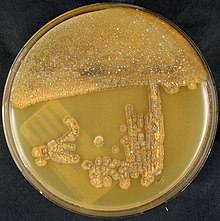| Amycolatopsis orientalis | |
|---|---|

| |
| Scientific classification | |
| Domain: | Bacteria |
| Phylum: | Actinomycetota |
| Class: | Actinomycetia |
| Order: | Pseudonocardiales |
| Family: | Pseudonocardiaceae |
| Genus: | Amycolatopsis |
| Species: | A. orientalis |
| Binomial name | |
| Amycolatopsis orientalis (Pittenger and Brigham 1956) Lechevalier et al. 1986 | |
| Type strain | |
| ATCC 19795 CIP 107113 DSM 40040 IFO 12806 ISP 5040 JCM 4235 JCM 4600 NBRC 12806 NRRL 2450 UNIQEM 181 VKM Ac-866 | |
| Synonyms | |
| |
Amycolatopsis orientalis is a Gram-positive bacterium in the phylum Actinomycetota. It produces several substances with antimicrobial properties, including the antibiotic drug vancomycin.
History
A. orientalis was originally discovered by Edmund Kornfeld, an organic chemist at Eli Lilly and Company, in a soil sample gathered by a missionary from forests on the island of Borneo. The antibiotic vancomycin was first isolated from the bacteria in 1953.
References
- ^ Lechevalier MP, Prauser H, Labeda DP, Ruan JS. (1986). "Two new genera of nocardioform actinomycetes: Amycolata gen. nov. and Amycolatopsis gen. nov". Int. J. Syst. Bacteriol. 36: 29–37. doi:10.1099/00207713-36-1-29.
- Grayson, M. Lindsay (2012). Kucers' the use of antibiotics a clinical review of antibacterial, antifungal, antiparasitic and antiviral drugs (6th ed.). Boca Raton, Florida: CRC Press. p. 569. ISBN 9781444147520.
- Kisil OV, Efimenko TA, Efremenkova OV (October 2021). "Looking Back to Amycolatopsis: History of the Antibiotic Discovery and Future Prospects". Antibiotics. 10 (10): 1254. doi:10.3390/antibiotics10101254. PMC 8532670. PMID 34680834.
There are more than 100 compounds of Amycolatopsis origin with described antibacterial activity and/or proven antibiotic biosynthesis gene presence. The most productive species are A. orientalis (12 antibiotics), A. mediterranei (5 antibiotics), and A. sulphurea (3 antibiotics).
- ^ Samanta, Indranil; Bandyopadhyay, Samiran (2019). Antimicrobial Resistance in Agriculture: Perspective, Policy and Mitigation. Elsevier Science. p. 205. ISBN 978-0-12-816523-2. Retrieved October 9, 2022.
Kornfield, an organic chemist at Eli Lilly, first isolated a bacterium namely Amycolatopsis orientalis (Streptomyces orientalis or Nocardia orientalis) from mud collected by a missionary from forests of Borneo island. A compound ('Mississippi mud' or compound 05,865) was extracted from the isolated bacteria and it was approved by FDA as vancomycin drug after clinical trials.
- Wang, J.; Sintim, H.O. (2014). "Antibiotics That Disrupt Cell Wall and Bacterial Membrane Formation and Integrity". Reference Module in Biomedical Sciences. Elsevier. p. 7. doi:10.1016/b978-0-12-801238-3.00016-7. ISBN 9780128012383.
Vancomycin ... was first isolated in 1953 from a soil sample containing a bacterial species named Amycolatopsis orientalis.
| Taxon identifiers | |
|---|---|
| Streptomyces orientalis | |
This Streptomyces-related article is a stub. You can help Misplaced Pages by expanding it. |